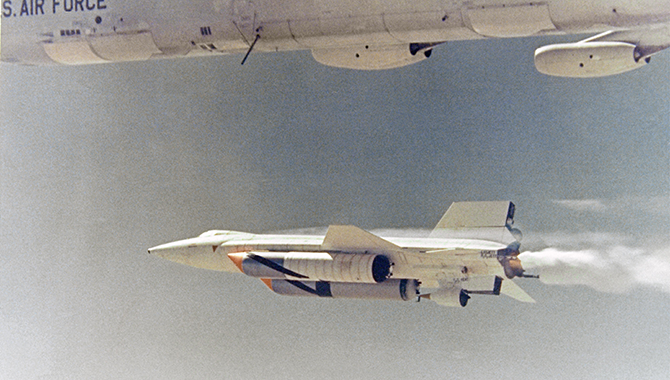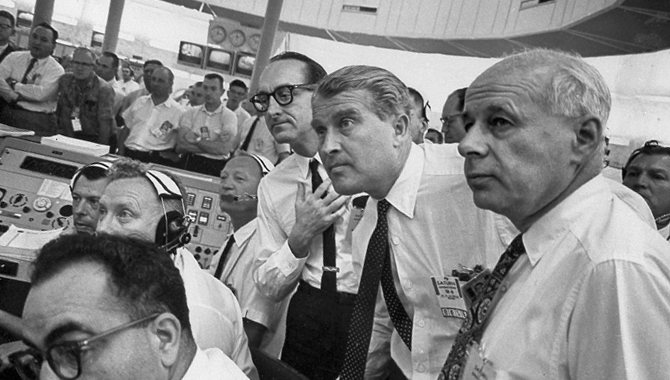
The X-15A-2 in flight with ablative coating and additional external fuel tanks.
Photo Credit: NASA
On October 3, 1967, U.S. Air Force pilot William “Pete” Knight set a world speed record in an X-15 rocket plane. Minutes later, the aircraft landed charred and broken.
Knight was one of 12 men who piloted the experimental X-15 planes. The flight research program, which ran from 1959 through 1968, was initiated as a joint effort between the U.S. Air Force, the U.S. Navy, and the U.S. National Advisory Committee for Aeronautics (NACA), which later became NASA. The program had two main objectives: to achieve hypersonic flight (Mach 5, or five times the speed of sound) and to penetrate space. It did both.
Speed was the initial focus of the program. Earlier X-plane programs, X-1 and X-2, had already broken the sound barrier (Mach 1). But when those planes had ventured toward hypersonic territory, they’d run into insurmountable stability problems. To overcome the stability issues, the X-15 team went back to the drawing board. The traditional solution to enhance stability would have been to increase the size of the aircraft’s tail. But X-15 engineers realized that the ideal solution might be a change in shape rather than size. So the X-15 planes emerged with a novel wedge-shaped tail: narrow at the front, wide at the back. This unusual structure kept the air streams apart during hypersonic flight, solving the stability concern.
Stability wasn’t the only challenge facing the X-15 program. Aerodynamic heating was considered an even greater problem: friction associated with reentry at hypersonic speeds was expected to produce temperatures in excess of 2,000 degrees Fahrenheit. No existing airframe material or insulation could withstand that kind of heat. So the engineers conceived a unique solution: an uninsulated, exposed Inconel X hot structure. The frame proved able to survive the ferocious heat of flight and reentry up to Mach 6, and the program achieved its goal of hypersonic flight.
But they wanted to go faster. In 1962, the mission was expanded to Mach 8. This required a rework of one of the three planes: X-15-2. Two large external propellant tanks, which could be jettisoned during flight, plus a small tank for liquid hydrogen were added. Alone, the extra fuel was not enough to explore flight dynamics at Mach 8. A special thermal coating was also needed to insulate the aircraft’s frame from the greater thermal loads associated with going eight times the speed of sound. The resulting spray-on ablative coating was expected to help the X-15 survive the heat, but it made the aircraft much heavier and harder to handle.
On October 3, 1967, the revamped and renamed X-15A-2 set off with Knight at the controls. The day was bright and clear. Like all the X-15 flights, a B-52 bomber carried the “spaceplane” up to 45,000 feet before releasing it. Knight switched on the rocket engine and shot away. Due to the extra propellant carried in the external fuel tanks, the engine burned for about a minute longer than usual. That’s all it took: Knight broke all previous X-15 records to set an unofficial world record of Mach 6.7 (4,519 miles per hour).
But the rocket plane did not survive the experience. The levels of frictional heating were higher than anticipated and the ablative coating didn’t work as well as hoped. The aircraft’s frame and wiring were damaged. It landed, skin melted in places, some parts missing entirely. Knight was fine but the plane never flew again.
That was the 188th flight of the X-15 program. The remaining two planes flew only 11 more times in total before the program was shut down. During its run, the pilots broke both speed and altitude records. In addition to Knight’s speed record in the X-15A-2, the program set an official world record for altitude on July 17, 1962, when Air Force pilot Robert “Bob” White reached 314,750 feet, and an unofficial altitude record of 354,200 feet on August 22, 1963, with NASA pilot Joseph Walker in the X-15-3. Beyond its records, the program provided unparalleled information on hypersonic flight, including aerodynamic performance, thermal control, structural response to heat and altitude, stability, and pilot physiology. Findings from the X-15 program contributed to the success of the Mercury, Gemini, Apollo, and Space Shuttle programs.
Learn more about the X-15 program.
Download an APPEL case study on the knowledge legacy of the X-15 program.









